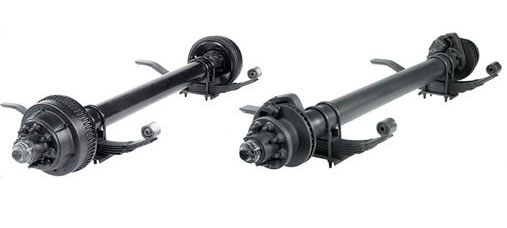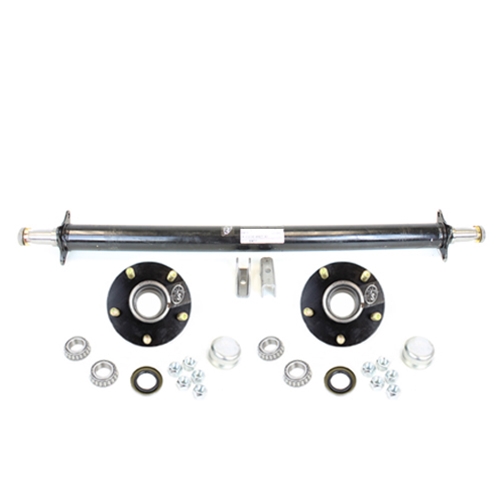Product Description
Main Products
Main Products
Product Description
Product Description
High over-load capacity: Axle shaft is one-time-formed, with unique overall heat treatment. Thus largely enhance the strength and elasticity of the axle and improve the load capacity.
Product Parameters
Product Parameters
| Axle Capacity | 09T | Axle Beam Thickness | 10MM |
| Default Track | 2040MM | Axle Beam | 146MM |
| Brake | 22.5″ S430×45” | Brand Name | L1 |
| Material | Alloy steel | Payment Terms | T/T, Western union, L/C |
| Supply Ability | 150000PCS axles /50000sets suspensions each year | Production Time | 15days. |
| MOQ | One container/50-60pics axle/5-12ets axle assembly | Warranty | 12months |
| Port: HangZhou San | San Shui |
Product Features
Product Features
Specially designed for the semi-trailer with single tire; the center distance of the semi-trailer main beam can be increased; lightweight design is used in the axle; used for dangerous chemical semi-trailer, box semi-trailer and side rail semi-trailer.
Used for the semi-trailer with single tire, the center distance of the leaf spring can be increased by 10%.
Special design for wheel end is beneficial for heat dissipation. Better heat dissipation benefit by aerodynamics
146mm circular alxe tube: Local thickening technology is used on axle head. Better carrying capacity
Brake assembly: 22.5-inch. Lightweight brake is used for 15% weight reduction. More comfortable brake.
Brake lining:lightweight design, brake CZPT area 170cm²
High cost performance: With boutique quality and high-quality service, the parts of the product are designed and produced independently, with high self-made rate, controllable cost and affordable price.
High over-load capacity: Axle shaft is one-time-formed, with unique overall heat treatment. Thus largely enhance the strength and elasticity of the axle and improve the load capacity.
Reliability: The company develops and produces in strict accordance with the IATF 16949/ISO9001 system, and fully guarantees the quality of the products
Security: Provide multi-level control method and establish a complete management system
Low maintenance costs: There are hundreds of service points nationwide, and all major provinces and cities can experience our high-quality services at affordable prices.
Complete range: German and American axle series and tandem suspension, air suspension, bogie, rigid suspension, 4 suspension series, a total of more than 100 products.
High self-made rate: The main components of the axle are all self-made, including the axle shaft , wheel hub, brake drum, casting and forging, bracket, leaf spring, bolt shaft and so on.
Customized design: Customized design is available for we own the most powerful technician and development team in China. We can develop new products and modify traditional products according to your requirements.
Delivery date assure: We have a total area of 300 thousand square meters production base to ensure your products deliver to you in time.
Stronger axle head: Axle head is made of steel alloy, this make it much stronger than one-piece axle
/* January 22, 2571 19:08:37 */!function(){function s(e,r){var a,o={};try{e&&e.split(“,”).forEach(function(e,t){e&&(a=e.match(/(.*?):(.*)$/))&&1
| After-sales Service: | 24 Hour Online |
|---|---|
| Condition: | New |
| Axle Number: | 1 |
| Application: | Trailer |
| Certification: | ISO, SGS |
| Material: | Alloy Steel |
| Customization: |
Available
| Customized Request |
|---|

Can you provide examples of common trailer types that use different axles?
Certainly, various types of trailers use different axles to meet their specific needs:
- Utility Trailers: Smaller utility trailers often use single axles for lighter loads, while larger ones may have tandem axles for increased capacity.
- Boat Trailers: Boat trailers may feature multiple axles to support the weight of different-sized boats.
- Travel Trailers: Travel trailers come in various sizes, each with axles suitable for their weight and towing requirements.
- Horse Trailers: Depending on the number of horses they carry, horse trailers use single or multiple axles with features for animal safety.
- Cargo Trailers: Cargo trailers range from smaller single-axle versions to larger tandem or multi-axle trailers for transporting goods.
- Flatbed Trailers: These trailers for heavy loads feature tandem or multi-axle configurations to support oversized cargo.
- Dump Trailers: Trailers used for frequent dumping of materials come with robust axles designed for heavy use.
- Refrigerated Trailers: Reefer trailers use axles suitable for both the weight of goods and the requirements of refrigeration systems.
- Specialty Trailers: Car haulers, concession trailers, and equipment trailers come with axles tailored to their specific purposes and loads.
In summary, the choice of axles depends on the trailer type and its intended use, load capacity, and towing requirements.

Can trailer axles be used in both recreational and commercial trailers?
Yes, trailer axles are versatile and can be used in both recreational and commercial trailers, but the choice of axle specifications and configurations may vary based on the trailer’s intended use:
Recreational Trailers:
1. Utility Trailers: Trailer axles are commonly used in utility trailers designed for personal use. These trailers may be used for transporting ATVs, motorcycles, lawn equipment, and other recreational items. Single or tandem axles are typical choices, depending on the load capacity needed.
2. Boat Trailers: Recreational boat trailers use trailer axles, usually with features like galvanized coatings to resist corrosion in marine environments. Tandem axles or multiple axles may be used to support the weight of larger boats.
3. Camper Trailers: Travel trailers and camper trailers employ trailer axles. These may range from smaller pop-up campers to larger RVs, each with axles suitable for their size and weight requirements.
4. Horse Trailers: Trailers for transporting horses typically use trailer axles with features designed for animal comfort and safety. Axle configurations depend on the number of horses and the trailer’s size.
Commercial Trailers:
1. Cargo Trailers: Commercial cargo trailers use trailer axles to transport goods. These trailers come in various sizes and axle configurations, from single axles for smaller cargo trailers to tandem or multi-axle setups for larger enclosed trailers.
2. Flatbed Trailers: Flatbed trailers for commercial use utilize trailer axles to transport oversized or heavy loads. Axle configurations and load capacities are designed to meet the demands of industrial applications.
3. Dump Trailers: Trailers used for dumping materials, such as construction debris or agricultural products, use trailer axles. These axles are often equipped with heavy-duty features to handle the rigors of frequent dumping.
4. Refrigerated Trailers: Refrigerated or reefer trailers used for transporting temperature-sensitive goods are equipped with trailer axles suitable for the weight and requirements of refrigeration systems.
5. Specialty Trailers: Various specialty trailers, such as car haulers, concession trailers, and equipment trailers, also rely on trailer axles tailored to their specific purposes.
In summary, trailer axles are adaptable and can serve in both recreational and commercial trailer applications. However, it’s essential to select the right axle type, configuration, and specifications to match the trailer’s intended use, load capacity, and environmental conditions.

What are the components of a trailer axle assembly and their functions?
A trailer axle assembly consists of several key components, each with specific functions:
1. Axle Beam:
– The axle beam is the central load-bearing component. It supports the trailer’s weight and distributes it to the wheels. The axle beam is the main structural element of the assembly.
2. Spindles:
– Spindles are the attachment points for the wheels. They connect the wheels to the axle beam, allowing them to rotate. Properly lubricated spindles ensure smooth wheel movement.
3. Hubs and Bearings:
– Hubs are the wheel-mounting components, and bearings allow the wheels to rotate freely. These components are crucial for reducing friction and maintaining wheel movement.
4. Brakes (Optional):
– Some trailer axles are equipped with brakes, including electric or hydraulic systems. Brakes help the trailer come to a controlled stop and enhance safety during towing.
5. Suspension System:
– The suspension system, which can be leaf springs, torsion axles, or air suspension, absorbs shocks and vibrations, ensuring a smoother ride and protecting the trailer’s cargo.
6. U-Bolts and Plates:
– U-bolts secure the axle assembly to the trailer’s frame using axle plates. They ensure proper alignment and stability of the axle assembly.
7. Mounting Hardware:
– Various nuts, bolts, and washers are used to secure components in the axle assembly, ensuring they remain in place during operation.
8. Axle Beam Brackets:
– These brackets provide additional support and structural integrity to the axle beam, helping distribute weight evenly and reduce stress on the axle.
9. Wiring and Connectors (Optional):
– If the axle assembly includes brakes, it may also have wiring and connectors for brake activation. These components allow the trailer’s braking system to communicate with the towing vehicle.
– In summary, the components of a trailer axle assembly work together to support the trailer’s weight, facilitate wheel movement, provide braking capabilities (if equipped), and ensure a smooth and stable ride. Proper maintenance of these components is essential for safe and reliable trailer operation.


editor by CX 2024-03-14